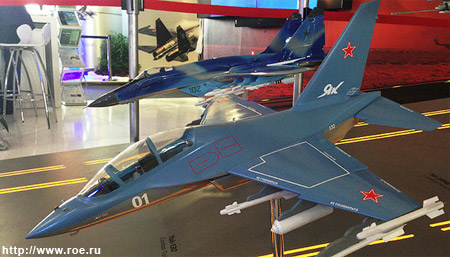Latin America Chooses Russia-Made Weapons
April 7, 2014

During the fair Rosoboronexport experts held a series of talks with high-ranking military officials from a number of Latin American countries. Chile expressed increased interest in the Yak-130 combat trainer aircraft, Mi-17-series military transport helicopters, Igla-S portable air defense systems and small arms, including Kalashnikov automatic rifle 100 series. The Podsolnukh-E shore-based sea control radar attracted special attention. Chile mulls acquiring Kamaz and Ural heavy trucks to use in mountainous areas and in desert. The Kamaz teams took the top three places in the recent Dakar-2014 rally. The route went through Argentina, Bolivia and Chile across extremely rugged terrain. Russia and Peru have a long history of cooperation. In December 2013 Peru signed a $500 million deal to buy 24 Mil Mi-171 transport helicopters for its military. T-90S tanks are next on the list. A real large-scale contract to purchase 110 vehicles is in works, so in 2013 Rosoboronexport let the Peruvians test the tank in local conditions. It did real well. A Peruvian delegation is expected to visit Russia and assess the tank’s combat capabilities during field tests. Peru mulls a deal to purchase BTR-80A armored personnel carriers (APC). The carrier stands out as the most reliable vehicle among contemporary APCs.
The Russia-Brazil military cooperation is the story of success. Helicopters are in focus. Combat Mi-35 and civilian version of Mi-17 choppers have already been delivered. Brazil expressed a desire to purchase Ka-62 which is in the development status now. It is also acquiring Russian Pantsir-S1 (SA-22 Greyhound) combined short-to-medium range surface-to-air missile and anti-aircraft artillery weapon system and Igla (SA-18 Grouse) short-range man-portable air defense system. Somewhere in June-August the parties plan to sign a contract. Brazilians have received detailed information on Pantsir-S1 thanks to close ties with the Federal State Unitary Enterprise - Instrument Design Bureau in Tula. Russian Rostekh and Brazilian Odebrecht Defesa e Tecnologia signed a cooperation agreement to last till the end of 2015. This is another element of bilateral strategic cooperation, including high-tech and military systems. Russia invited Brazil to join in the T-50 fifth-generation fighter program. It is also offered to launch Pantsir-S1 license production under a new brand. The talks with the Brazilian partner continue.
Venezuela is a large Latin American importer of Russian arms. Rosoboronexport signed its first contract on March 10, 2005 in Caracas, no matter the US vehemently opposed it. Thanks to Russia the military quickly boosted its combat capabilities. The country was the first to receive Mi-35M combat helicopters and the state-of-the-art S-300VM "Antey-2500" (SA-23 GladiatorGiant), a Russian air-defense/ballistic missile capable air defense system. The Antey-2500 is designed to defeat short- and medium-range ballistic missiles, ballistic and cruise missiles, fixed wing aircraft, as well as loitering ECM platforms and precision-guided munitions. Venezuela has the Pechora-2M air defense system in its inventory, which is the best of its kind. It is a surface-to-air anti-aircraft short-range missile system designed for destruction of aircraft, cruise missiles, assault helicopters and other air targets at low and medium attitudes. The Venezuelan air defense capability is also bolstered by Buk-M2 systems (Grizzly SA-17) self-propelled medium-range surface-to-air missile system to provide for reliable defense of its skies. The army’s inventory boasts MLRS (multiple-launch rocket system) Smerch, 155-mm artillery pieces and MSTA-S howitzers. The Air Force has SU-30 MK2 combat aircraft which have demonstrated their capabilities by neutralizing in a short period of time around two dozen planes of drug traffickers from Mexico, Central America, Columbia and the Caribbean. The building of a factory of K-103 assault rifles in Maracay, capital city of central Aragua state, is coming to an end soon, as well as a factory to produce ammunition. All in all, Venezuela has spent $12 billion to purchase Russia-made weapons.
Other states are to follow. The military experts of ALBA (Bolivarian Alliance for the Americas) note more often that the Pentagon is not omnipotent. The desire of Latin American states to boost military cooperation with Russia grows stronger as more warnings come from Washington.
The Russian helicopters have got a real boost on the Latin American market. There are over 500 rotary-wing aircraft in the inventory of Latin American countries from Mexico to Argentina! The Russian military industry will need a few years of intensive efforts to carry out its obligations on air defense systems to be delivered to Latin America. The Russian armor, multiple-launch rocket systems and small arms are always in focus of attention during the Latin American military equipment fairs. The Pentagon does its best to prevent the Russian weapons come to the region, but the days of puppet regimes and corrupted ministers of defense are becoming history. More and more often Latin America speaks with its own voice without looking back at Washington. China, not the United States, appears to be the main rival of Russia on the Latin American arms market.